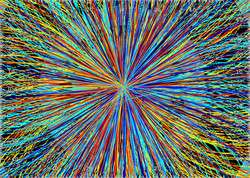The perfect liquid -- now even more perfect

Ultra hot quark-gluon-plasma, generated by heavy-ion collisions in particle accelerators, is supposed to be the "most perfect fluid" in the world. Previous theories imposed a limit on how "liquid" fluids can be. Recent results at the Vienna University of Technology suggest that this limit can be broken -- making the world's "most perfect fluid" even more perfect.
How liquid can a fluid be? This is a question particle physicists at the Vienna University of Technology have been working on. The "most perfect liquid" is nothing like water, but the extremely hot quark-gluon-plasma which is produced in heavy-ion collisions at the Large Hadron Collider at CERN. New theoretical results at Vienna UT show that this quark-gluon plasma could be even less viscous than was deemed possible by previous theories. The results were published in Physical Review Letters and highlighted as an "editors' selection".
Highly viscous liquids (such as honey) are thick and have strong internal friction, quantum liquids, such as super fluid helium can exhibit extremely low viscosity. In 2004, theorists claimed that quantum theory provided a lower bound for viscosity of fluids. Applying methods from string theory, the lowest possible ratio of viscosity to the entropy density was predicted to be ħ/4π (with the Planck-constant ħ). Even super fluid helium is far above this threshold. In 2005, measurements showed that quark-gluon-plasma exhibits a viscosity just barely above this limit. However, this record for low viscosity can still be broken, claims Dominik Steineder from the Institute for Theoretical Physics at Vienna UT. He obtained this remarkable result working as a PhD-student with Professor Anton Rebhan.
The viscosity of a quark-gluon plasma cannot be calculated directly. Its behavior is so complicated that very sophisticated methods have to be applied, says Anton Rebhan: "Using string theory, the quantum field theory of quark-gluon plasma can be related to the physics of black holes in higher dimensions. So we are solving equations from string theory and then transfer the results to the physics of the quark-gluon plasma." The previously established lower bound for viscosity was calculated in a very similar way. However, in these calculations the plasma was modeled to be symmetric and isotropic. "In fact, a plasma produced by a collision in a particle accelerator is not isotropic at the beginning", says Anton Rebhan. The particles are accelerated and collided along one specific direction – so the resulting plasma shows different properties, depending on the direction from which one looks at it.
The physicists at Vienna UT found a way to include this anisotropy in their equations – and surprisingly the limit for the viscosity can be broken in this new model. "The viscosity depends on several other physical parameters, but it can be lower than the number previously considered to be the absolute lower bound", Dominik Steineder explains. The on-going quark-gluon-experiments at CERN will provide opportunities for testing the new theoretical predictions.
More information: prl.aps.org/abstract/PRL/v108/i2/e021601
Provided by Vienna University of Technology




















